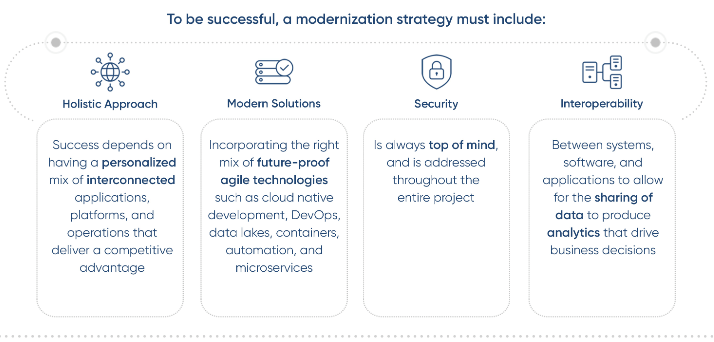
Application-based companies are changing the business landscape. Digital models have disrupted legacy companies in every industry and sector. For example, Uber and Lyft changed the way we think about transportation. Amazon has supplanted countless retailers across the world, and investing has become more accessible to the working class because of companies like Robinhood. Calling on CBTS Application Modernization services can give companies the edge they need to compete in the digital age.
Unfortunately, many companies struggle to begin modernizing due to the costly investment and sometimes complex infrastructure strategy. (Even though legacy application architecture can easily consume a considerable portion of a business’s IT budget.) Thankfully, companies don’t have to go it alone.
This blog will outline how the CBTS holistic APO (applications, platforms, operations) approach to application modernization services can future-proof and streamline operations, securely integrate platforms, and manage applications via cloud-first environments.
Table of contents:
- App modernization defined
- Benefits of app modernization
- Navigating the application era
- APO: What is it, and why does it matter?
- Applications that work for you
- Secure, scalable platforms
- Optimized operations
- The CBTS approach to application modernization services
- Holistic approach
- Modern solutions
- Security
- Interoperability
- Connecting the dots
- Future-proof your business with CBTS
App Modernization defined
What exactly is application modernization? A precise definition has been elusive because service providers tend to offer explanations that suit their specific offerings. However, over our decades of experience, CBTS has put together an agnostic definition of application modernization.
Application modernization is the process of rewriting, re-architecting, and re-platforming applications into cloud-native modern apps designed for resiliency, scale, and speed to market.
Benefits of application modernization services
In addition to gaining a competitive edge, there are a host of other benefits to digital transformation:
- Improved customer experience through simple, responsive interfaces that enhance customer experience
- Continuous deployment of new features
- Cloud-native architecture that extends future-proofed scalability, performance, flexibility, and availability
- Promote a culture of ownership and trust while improving an organization’s agility by utilizing DevOps best practices
- Improved security incorporated directly into the app build cycle

Navigating the application era
Businesses can no longer afford to think of themselves as service providers that utilize apps. Instead, every company should think of itself as an application company that happens to sell products or services. Apps are no longer a marketing gimmick; today, they are a matter of survival.
Employing application modernization services is a powerful way for a business to update its operations across all departments—especially in the customer-facing realm. Modernized applications utilize a cloud-native architecture, providing greater flexibility, scalability, performance, and availability. Application modernization services are the key to future-proofing business operations.
However, many businesses are resistant to the idea of digital transformation. Understandably, companies fear significant infrastructure investments. They may lack the qualified staff to drive the change, or there may be concerns about system downtime. In many cases, these fears are justified. Most technology integrators provide point solutions as opposed to a holistic approach.
Watch the CBTS tech talk: 3 critical goals for application modernization initiatives
APO: What is it, and why does it matter?
It’s not enough to upgrade or rewrite a client’s applications. The true value for our clients is streamlining operations by connecting and optimizing those modernized applications and platforms.
The CBTS approach—coined APO (applications, platforms, operations)—encompasses the spirit of our commitment to client success.
Applications that work for you
In today’s world, cloud-native apps are the key to a thriving business. The CBTS application development process helps you achieve:
- Seamless, secure migration.
- Continuous deployment of new features.
- Future-proof scalability.
- Improved availability.
Secure, scalable platforms
Through our various application modernization services, CBTS can take over or help manage existing environments—compute, network, or storage—through:
- Managed services.
- Public Cloud lift and shift.
- On-premises private Cloud.
- Infrastructure and hardware upgrades.
Optimized operations
Connecting employees to apps requires a coherent approach with security, networking, collaboration, and platform considerations. CBTS helps our clients accomplish optimized operations through:
- Cyber security consulting, products, and services.
- Network as a Service (NaaS) and SD-WAN.
- Collaboration platform integration and customization, including Microsoft Teams and WebEx.
- Hardware and infrastructure design and deployment.
Download the e-book: CIO’s Definitive Guide to Safely Migrating Applications to the Cloud
The CBTS approach to application modernization services
How does CBTS use APO to achieve exceptional results? This comprehensive strategy hinges on four pillars: a holistic approach, modern solutions, security, and interoperability.
Holistic approach
Gaining a competitive advantage requires a personalized mix of interconnected apps, platforms, and operations.
CBTS takes a holistic approach to navigating your transformation journey by:
- Creating secure and scalable platforms.
- Developing and deploying modernized apps.
- Managing, monitoring, and optimizing your operations.
First, our project managers help our clients prioritize which legacy apps should be modernized with cloud-native development. Next, the team assesses and documents the current application environment to craft a customized roadmap outlining our clients’ complete transformation process.
Download the e-book: CIO Field Guide: Cloud Assessment Services
Modern solutions
A truly modern solution incorporates a mix of future-proof, agile technologies such as cloud-native development, DevOps, data lakes, containers, automation, and microservices. Adopting DevOps best practices improves collaboration between app development and IT operations teams while driving a culture of innovation and continuous process improvement.
Security
Moving apps to the Cloud does not always reduce risk or complexity if they are not appropriately designed and managed. Companies should be aware of the most common challenges associated with cloud security and how they can mitigate complications.
Security oversights. One of the biggest challenges is migrating safely. One wrong step and a company can put themselves and their customers at risk. Assess the challenges at the forefront and bake in security as you go. Common cloud security mistakes include unsecured storage containers, poorly set access rights, and open ports.
Legacy systems have outdated data security measures. Legacy systems have outdated data security measures and open companies up to security risks. Critical security updates can be risky to implement, often breaking older systems.
Secure data
Customized applications made specifically for your business can reinforce your data security system. They are built to provide full compliance with all regulations, enable the protection of vulnerable data, and reduce the chances of intrusion.
Embed security at each stage of the process. Inspect the security of your legacy systems and fix issues immediately. Encrypt data and implement strong access/authorization measures.
Operations teams should have dedicated personnel who constantly analyze the threat landscape and implement security measures that minimize risks to the organization. Additionally, staying on the cutting edge of security technology is essential. CBTS managed security services include:
- Vulnerability and patch management.
- Security assessments.
- Penetration testing.
- AI-powered threat detection and response.
Also read: Q&A: Secure networking utilizing robust SD-WAN solutions
Interoperability
Application modernization is somewhat worthless if it creates communications incompatibility between your systems. The CBTS approach ensures interoperability between systems, software, and applications, allowing data sharing to produce data and analytics that drive business decisions.
Connecting the dots
The sum of application modernization services is greater than the whole. When clients step back from the individual pieces of APO, they see the power of the interconnected systems.
To enable long-term success, the CBTS strategy boasts:
- Outcome-based assessments.
- Continuous cloud-native application development.
- A secure application migration roadmap.
- Ongoing, optimized operations support.
Future-proof your business with CBTS
Modern customers demand intuitive, responsive applications with up-to-the-second updated information. A company’s platforms must be highly secure—following data governance and risk assessment protocols, policies, and procedures—and scalable on demand to optimize operations fully.
CBTS is well-suited to help our clients meet these challenges—developing and deploying modern applications and secure, scalable platforms; and the ongoing management, monitoring, and optimization of their operations. CBTS application modernization services take a holistic approach to navigating your app modernization journey.




















